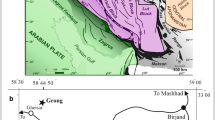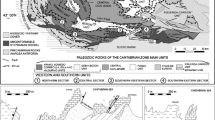Abstract
A new thecate hydroid from the Maastrichtian Chalk (Upper Maastrichtian) preserved by bioimmuration is described asFilelloides cretacea n. g. n. sp. It comprises five hydrothecae of a hydrozoan colony settling upon an algae sheet, which were overgrown by a disc-shaped cyclostome bryozoan colony of the genusActinopora. Its basal face shows the negative relief of the throughout annulated hydrothecae which are extremely well molded in all details. Among Recent colonial Hydroida the genusFilellum Hincks of the family Lafoeidae is the nearest relative, our specimen differs from the latter in that the hydrothecae are not connated with the hydrocaulus or the hydrorhiza.Filelloides n. g. is one of the few non-mineralized Cretaceous hydrozoan genera. Their rare record in the Mesozoic contrasts with their fairly common occurrence in the Palaeozoic.
Kurzfassung
Unter dem NamenFilelloides creatacea n. g. n. sp. wird ein durch Bioimmuration erhaltener Hydrozoenfund aus der Maastrichter Tuffkreide (Oberes Maastrichtium) beschrieben. Es handelt sich um die Abformung von fünf Hydrotheken einer auf einem Algenthallus siedelnden thecaten Hydroiden-Kolonie, die ihrerseits von einer scheibenförmigen Kolonie der Bryozoen-GattungActinopora überwachsen wurde. Diese zeigt auf ihrer Basalseite das in seinen feinsten Einzelheiten abgeformte Negativ-Relief der quergeringelten Hydrotheken. Unter den rezenten („chitinösen“) koloniebildenden Hydrozoen steht die GattungFilellum Hincks (Fam. Lafoeidae) der fossiíen Art am nächsten, unterscheidet sich jedoch von ihr dadurch, daß die Hydrotheken nicht mit den Hydrocauli oder der Hydrorhiza verwachsen sind.Filelloides n. g. ist eine der wenigen nicht mineralisierten kretazischen HydrozoenGattungen. Ihre seltene Überlieferung im Mesozoikum steht im Gegensatz zu ihrer weit häufigeren Erhaltung im Paläozoikum.
Similar content being viewed by others
Literatur
Alloiteau, J. 1952. Classe des Hydrozoaires. — [In:]Piveteau, J. (ed.) Traité de Paléontologie1: 377–398, Paris.
Bischoff, G. C. O. 1978. Internai structures of conulariid tests and their functional significance, with special reference to Circonulariina n. suborder (Cnidaria, Scyphozoa). — Senckenbergiana lethaea59 (4/6): 275–327, Frankfurt am Main.
—— 1989. Byroniida new order from early Palaeozoic strata of eastern Australia (Cnidaria, thecate scyphopolyps). — Senckenbergiana lethaea69 (5/6): 467–521, Frankfurt am Main.
Cornelius, P. F. S. 1975. A revision of the species of Lafoeidae and Haleciidae (Coelenterata: Hydroida) recorded from Britain and nearby seas. — Bulletin British Museum of natural History (Zoology)28: 373–426, London.
DÜcker, A. 1964. Kleinformen der Gletschererosion an Geschieben. — Lauenburgische Heimat, Neue Folge 30,45: 26–37, Ratzeburg.
FlÜgel, E. 1975. Fossile Hydrozoen — Kenntnisstand und Probleme. — Paläontologische Zeitschrift49 (4): 369–406, Stuttgart.
Gauger, W. 1981. Vorgänge an Feuersteinen von der oberen Kreidezeit bis heute—Feuersteinstudie III. — Jahrbuch des Naturwissenschaftlichen Vereins Fürstentum Lüneburg35: 233–258, Lüneburg.
Gregory, J. W. 1909. Catalogue of the fossil Bryozoa in the Department of the British Museum (Natural History) — The Cretaceous BryozoaII: I-XLVIII, 9 Taf., 75 Abb., London.
Hill, D. &Wells, J. W. 1956. Hydroida and Spongiomorphida. — [In:]Moore, R. C. (ed.) Treatise on Invertebrate Paleontology. Part F, Coelenterata: F81-F89,12 Abb., University of Kansas Press and Geological Society of Amerika, Lawrence and New York.
Jarms, G. 1990. Neubeschreibung dreier Arten der Gattung Nausithoe (Coronatae, Scyphozoa) sowie Wiederbeschreibung der ArtNausithoe marginata Kölliker, 1853. — Mitteilungen des hamburgischen zoologischen Museums und Instituts87: 7–39, Hamburg.
—— 1991. Taxonomic characters from the polyp tubes of coronate medusae (Scyphozoa, Coronatae). — [In:]Williams, R. B.;Cornelius, P. F. S.;Hughes, R. G. &Robson, E. A. (eds) Coelenterate Biology: Recent Research on Cnidaria and Ctenophora. — Hydrobiologia216/217: 463–470, London.
Kozlowski, R. 1967. Sur certains fossiles Ordoviciens à test organique. — Acta palaeontologica Polonica12: 99–132, Warszawa.
KrÜger, F. J. 1974. Beobachtungen an einen pleistozänen Flintgeschiebe. — Der Aufschluß25 (12): 627–631, Heidelberg.
KÜhn, O. 1939. Hydrozoa. — [In:]Schindewolf, O. H. (ed.) Handbuch der Paläozoologie2A: 1–68, 96 Abb., Berlin.
Millard, N. A. H. 1975. Monograph on the Hydroida of Southern Africa. — Annals of the South African Museum68: 1–513, Cape Town.
Naumov, D. V. 1969. Hydroids and hydromedusae of the U.S.S.R. — Fauna S.S.S.R.70: 1–660, Israel Programm for Scientific Translations, Jerusalem.
Nicholson, H. A. &Murie, J. 1978. On the minute structure of Stromatopora and its allies. — Journal of the Linnean Society14: 187–246, Taf. 1-4, Abb. 1-5, London.
Richters, F. 1913.Kristinella monilifera n. g., n. sp. Ein Hydroidpolyp aus der Kreide. — Zoologischer Anzeiger41: 553–556, Leipzig.
—— 1914. Berichtigung. — Zoologischer Anzeiger44: 288, Leipzig.
Taylor, P. D. 1988. A probable thecate hydroid from the Upper Cretaceous of southern England preserved by bioimmuration. — Paläontologische Zeitschrift62: 167–174, Stuttgart.
Taylor, P. D. &Todd, J. A. 1990. Sandwiched fossils. — Geology Today 1990: 151–154, Oxford.
Voigt, E. 1966. Die Erhaltung vergänglicher Organismen durch Abformung infolge Inkrustation durch sessile Tiere.— Neues Jahrbuch für Geologie und Paläontologie Abhandlungen125: 401–422, Stuttgart.
—— 1973.Hydrallmania graptolithiformis n. sp., eine durch Biomuration erhaltene Sertulariidae (Hydrozoa) aus der Maastrichter Tuffkreide. — Paläontologische Zeitschrift47 (1/2): 25–31, Stuttgart.
—— 1981. Erster fossiler Nachweis des Algen-GenusFosliella Howe, 1920 (Corallinaceae; Rhodophyceae) in der Maastrichter und Kunrader Kreide (Maastrichtium, Oberkreide). — Facies5: 265–282, Taf. 67-69, Erlangen.
—— 1983. Fossilerhaltung durch Bioimmuration:Aetea Lamouroux (Bryozoa Cheilostomata) aus dem Mittelmeerraum (Pliozän und rezent). — Facies9: 285–310, Erlangen.
Voigt, E. &Harmelin, J.-G. 1986. Erster mutmaßlicher Nachweis des ChlorophyceengenusCodium in der Oberkreide. — Senckenbergiana maritima18: 253–273, 2 Abb., 4 Taf., Frankfurt.
Werner, B. 1970. Contribution to the evolution in the genusStephanoscyphus (Scyphozoa, Coronatae) and ecology and regeneration qualities ofStephanoscyphus racemosus. — Publications of the Seto marine biological Laboratoy18: 1–20, Shirahama Wakayama-Ken.
—— 1979. Coloniality in the Scyphozoa: Cnidaria. — [In:]Larwood, G. &Rosen, B. R. (eds.) Biology and Systematics of Colonial Organisms: 81–103, Academic Press, London.
—— 1984. Stamm Cnidaria, Nesseltiere. — [In:]Gruner, G. E. (ed.) Lehrbuch der speziellen Zoologie (co-ordinated by A. Kaestner). Band I: Wirbellose Tiere. 2. Teil: Cnidaria: 11–305, Fischer, Stuttgart.
Author information
Authors and Affiliations
Rights and permissions
About this article
Cite this article
Jarms, G., Voigt, E. Filelloides cretacea n. g. n. sp., ein durch Bioimmuration überlieferter Vertreter der Ordnung Hydroida (Hydrozoa) aus der Maastrichter Tuffkreide (Obermaastrichtium). Paläont. Z. 68, 211–221 (1994). https://doi.org/10.1007/BF02989441
Received:
Accepted:
Published:
Issue Date:
DOI: https://doi.org/10.1007/BF02989441




